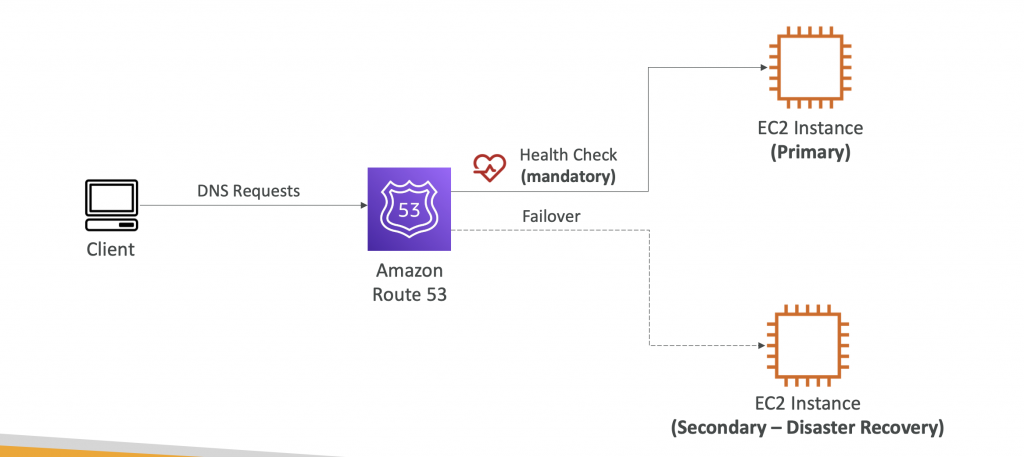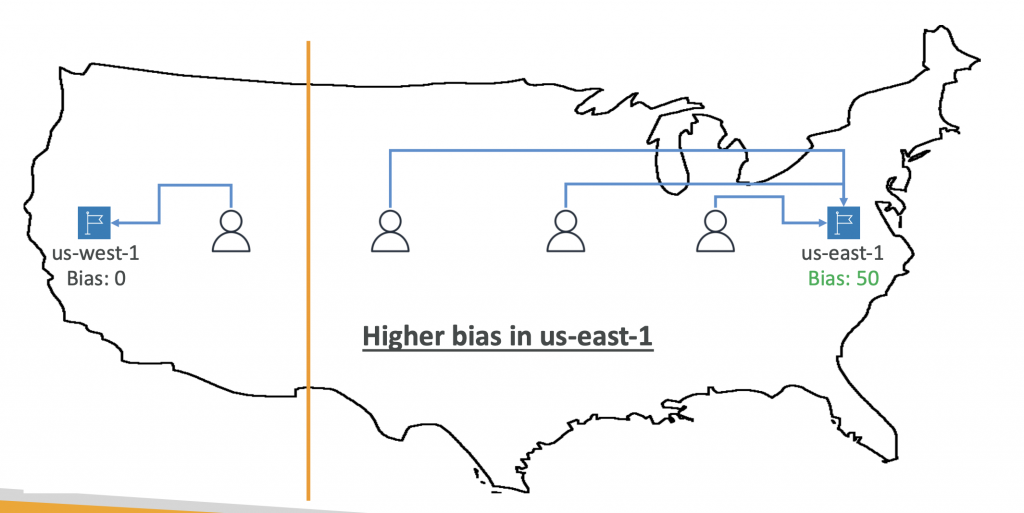This blog is a part of my journey “Embarking on the AWS Solution Architect Associate SAA-CO3 Certification Journey”
What is DNS?
- Domain Name System which translates the human friendly hostnames into the machine IP addresses.
- DNS is the backbone of the Internet
- DNS uses hierarchical naming structure
DNS Terminologies
- Domain Registrar : Amazon Route 53, GoDaddy
- DNS Records: A, AAAA, CNAME, NS
- Zone File: contains DNS records
- Name Server: resolves DNS queries (Authoritative or Non-Authoritative)
- Top Level Domain (TLD): .com, .us, .in, .gov, .org,
- Second Level Domain (SLD): amazon.com, google.com
Amazon Route 53
- A highly available, scalable, fully managed and Authoritative DNS
- Authoritative = the customer (you) can update the DNS records
- Route 53 is also a Domain Registrar
- Has ability to check the health of your resources
- The only AWS service which provides 100% availability SLA
- Why Route 53? 53 is a reference to the traditional DNS port
Route 53 – Records
- How you want to route traffic for a domain.
- Each record contains:
- Domain/subdomain Name – e.g., example.com
- Record Type – e.g., A or AAAA
- Value – e.g., 12.34.56.78
- Routing Policy – how Route 53 responds to queries
- TTL – amount of time the record cached at DNS Resolvers
- Route 53 supports the following DNS record types:
- (must know)A /AAAA / CNAME / NS
- (advanced)CAA/DS/MX/NAPTR/PTR/SOA/TXT/SPF/SRV
Record Types
- A – maps a hostname to IPv4
- AAAA – maps a hostname to IPv6
- CNAME – maps a hostname to another hostname
- The target is a domain name which must have an A or AAAA record
- Can’t create a CNAME record for the top node of a DNS namespace (Zone Apex)
- Example: you can’t create for example.com, but you can create for www.example.com
- NS – Name Servers for the Hosted Zone
- Control how traffic is routed for a domain
Hosted Zones
- A container for records that define how to route traffic to a domain and its subdomains
- Public Hosted Zones – contains records that specify how to route traffic on the Internet (public domain names) application1.mypublicdomain.com
- Private Hosted Zones – contain records that specify how you route traffic within one or more VPCs (private domain names) application1.company.internal
- You pay $0.50 per month per hosted zone
Records TTL (Time To Live)
- High TTL – e.g., 24 hr
- Less traffic on Route 53
- Possibly outdated records
- Low TTL – e.g., 60 sec.
- More traffic on Route 53 ($$)
- Records are outdated for less time
- Easy to change records
- Except for Alias records, TTL is mandatory for each DNS record
CNAME vs Alias
- AWS Resources (Load Balancer, CloudFront…) expose an AWS hostname: lb1-1234.us-east-2.elb.amazonaws.com and you want myapp.mydomain.com
- CNAME
- Points a hostname to any other hostname. (app.mydomain.com => blabla.anything.com)
- ONLY FOR NON ROOT DOMAIN (aka. something.mydomain.com)
- Alias
- Points a hostname to an AWS Resource (app.mydomain.com => blabla.amazonaws.com
- Works for ROOT DOMAIN and NON ROOT DOMAIN (aka mydomain.com)
- Free of charge
- Native health check
Alias Records
- Maps a hostname to an AWS resource
- An extension to DNS functionality
- Automatically recognizes changes in the resource’s IP addresses
- Unlike CNAME, it can be used for the top node of a DNS namespace (Zone Apex), e.g.: example.com
- Alias Record is always of type A/AAAA for AWS resources (IPv4 / IPv6)
- You can’t set the TTL
- Alias Records Targets
- Elastic Load Balancers
- CloudFront Distributions
- API Gateway
- Elastic Beanstalk environments
- S3 Websites
- VPC Interface Endpoints
- Global Accelerator accelerator
- Route 53 record in the same hosted zone
- You cannot set an ALIAS record for an EC2 DNS name
Routing Policies
- Define how Route 53 responds to DNS queries
- Don’t get confused by the word “Routing”
- It’s not the same as Load balancer routing which routes the traffic
- DNS does not route any traffic, it only responds to the DNS queries
- Route 53 Supports the following Routing Policies
- Simple
- Weighted
- Failover
- Latency based
- Geolocation
- Multi-Value Answer
- Geoproximity
Routing Policies – Simple
- Typically, route traffic to a single resource
- Can specify multiple values in the same record
- If multiple values are returned, a random one is chosen by the client
- When Alias enabled, specify only one AWS resource
- Can’t be associated with Health Checks
Routing Policies – Weighted
- Control the % of the requests that go to each specific resource
- Assign each record a relative weight:
- Weights don’t need to sum up to 100
- DNS records must have the same name and type
- Can be associated with Health Checks
- Use cases: load balancing between regions, testing new application versions
- Assign a weight of 0 to a record to stop sending traffic to a resource
- If all records have weight of 0, then all records will be returned equally
Routing Policies – Latency-based
- Redirect to the resource that has the least latency close to us
- Super helpful when latency for users is a priority
- Latency is based on traffic between users and AWS Regions
- Germany users may be directed to the US (if that’s the lowest latency)
- Can be associated with Health Checks (has a failover capability)
Routing Policies – Failover

Routing Policies – Geolocation
- Different from Latency-based!
- This routing is based on user location
- Specify location by Continent, Country or by US State (if there’s overlapping, most precise location selected)
- Should create a “Default” record (in case there’s no match on location)
- Use cases: website localization, restrict content distribution, load balancing
- Can be associated with Health Checks
Routing Policies – Geoproximity
- Route traffic to your resources based on the geographic location of users and resources
- Ability to shift more traffic to resources based on the defined bias
- To change the size of the geographic region, specify bias values:
- To expand (1 to 99) – more traffic to the resource
- To shrink (-1 to -99) – less traffic to the resource
- Resources can be:
- AWS resources (specify AWS region)
- Non-AWS resources (specify Latitude and Longitude)
- You must use Route 53 Traffic Flow to use this feature

Routing Policies – IP-based Routing
- Routing is based on clients’ IP addresses
- You provide a list of CIDRs for your clients and the corresponding endpoints/locations (user-IP-to-endpoint mappings)
- Use cases: Optimize performance, reduce network costs
- Example: route end users from a particular ISP to a specific endpoint
Routing Policies – Multi-Value
- Use when routing traffic to multiple resources
- Route 53 return multiple values/resources
- Can be associated with Health Checks (return only values for healthy resources)
- Up to 8 healthy records are returned for each Multi-Value query
- Multi-Value is not a substitute for having an ELB
